Why Stock and Full Spline NV4500 Mainshafts Fail
Owners of diesel trucks equipped with NV4500 5-speed transmissions have been looking for a cure for 5th gear failures from as early as 1993. The problem has been experienced with both General Motors trucks using the 6.5l V8 Diesel and Dodge trucks with the 5.9l inline 6 cylinder Cummins Diesel engine. So, exactly what is the problem, and what is being done about it?
2019 NOTE: This article was originally written in 2005 when the last Cummins-powered truck built with the NV4500HD was only 1 year old. The facts presented in this article are still valid today, however, due to the advancing age of the affected trucks, we no longer offer the expense to make Torque King Mainshaft and RetroFit Kits mentioned below. See our NV4500 Web Pages for current mainshaft choices:
1992-2008 Chevy and GMC NV4500
1992-1993 Dodge NV4500
1994-2002 Dodge NV4500
2003-20054 Dodge NV4500
I Lost 5th Gear!
Almost all cases of mainshaft fifth gear failure can be directly attributed to insufficient support for the 5th gear. In the classic case, the nut retaining the mainshaft fifth gear backs off allowing the gear to slide back in the transmission extension housing and out of contact with the countershaft 5th gear. This failure usually occurs without warning or noise. You are driving happily along in 5th gear, either you (or your cruise control) lets off on the accelerator for a moment. You step on the accelerator to resume speed and the engine races, but your transmission is no longer transmitting power! White-faced and shocked, you mutter what the #%!! as you check to make sure the shifter is still in fifth, then downshift to fourth and let the clutch out. Your truck responds instantly as power is returned to the rear axle. Your blood pressure lowers a bit and you try to upshift to 5th. Again no power and no noise. You mutter, “Oh no, I lost fifth gear!” Just back into fourth and away you go. Now, you’re wondering if you are going to make it home and how much this will cost you to fix.
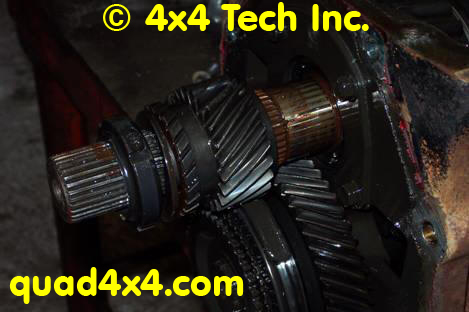
Typical 5th gear failure on a stock NV4500HD transmission. Note the reddish/orange sludge discoloring the shaft. This is a sign of wear or fretting. What you see is actually oxidized metal particles worn from the gear and shaft. Vibration and cyclic loads are the main causes of fretting.
Every time someone tells me I lost 5th gear, I am reminded of an occurrence in my youth. I was riding to school on a Brockway school bus. We had a lady bus driver who was a chronic gear grinder. One morning, when she was unable to force the transmission into fifth gear, she radioed the school that I lost 5th gear. The reply was something to the effect of, “What’d you do, drop it on the ground?” I presume she had little solace with that reply, but she bravely continued on in 4th gear and we all eventually arrived at school. Like my bus driver, you too will probably also make it to your destination after your 4500 turns itself into a 4-speed because this type of failure normally does not cause incapacitating damage in the short term. Chances are, what occurred inside your transmission was simply the 5th gear wore into the mainshaft. Once the gear is loose, it will work the nut off until the gear slides back and your day is ruined.
Nut Woes: Band-Aid Approach to A Serious Problem
The initial attempts to prevent 5th gear failures focused on the retaining nut which was a flat nut without a lockwasher in the original configuration. New Venture first added a lip on the nut that could be crimped into a key slot, then a concave spring lockwasher, and lastly a split nut with a cross-bolt to increase the thread contact. The aftermarket weighed in with at least two styles of nuts with set screws. Several chemical threads locking compounds have also been tried. None of these fixes were successful in keeping the gear on the shaft. They failed because they address the consequence of the failure instead of the cause. (Continue reading to find out the reasons.)
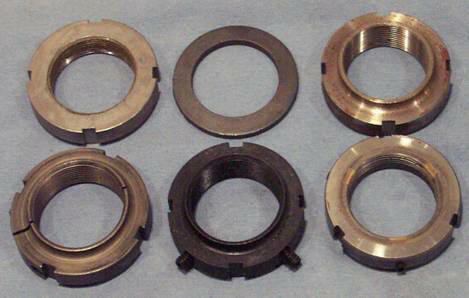
Clockwise from top left: flat nut, concave washer, crimp lock nut, cross-bolt lock nut, aftermarket nut with 2 set screws, aftermarket nut with 3 set screws, and brass pads.
Overloading Aggravates Problem
Before discussing the problems associated with factory partial spline and aftermarket full spline mainshaft designs, I want to point out that they are good quality parts made by reputable manufacturers. The 5th gear failings they have are not metallurgy or workmanship related. Shaft wear and gear failure are primarily due to design, but diesel engine harmonics and overloading also are significant factors. Owners of diesel-powered NV4500-equipped trucks often greatly exceed the recommended horsepower and load ratings for their vehicles. We have seen these trucks with engines putting out over 500 horsepower and 1, 000 ft-lbs. of torque. We have also seen the combined truck and trailer weights exceeding 40, 000 lbs.. Now, when you consider the NV4500 is rated for up to 460 ft-lbs. of torque and 19, 000 lbs. combined truck and trailer weight, you can see why part of the responsibility for transmission problems must rest on the shoulders of truck owners who grossly exceed the vehicle design limits and insist on making their or 1-ton work like a 2 or 3-ton truck
Mainshaft Types and Weak Points
To support the 5th gear, the factory mainshaft has both a splined area to transmit torque and a smooth machined surface for the fully internal spline gear to press onto. The end of the mainshaft is drilled and tapped for a pull rod so the gear may be pressed on the shaft without damaging other components inside the transmission. With this type of shaft, only the tips of the gear splines are in contact with the machined support surface of the shaft. This area is also directly under the gear teeth. Over time, the gear splines will actually wear into the shaft. As this wear continues, the fit between the gear and shaft becomes progressively looser. At this point, every time you accelerate or decelerate in fifth gear, the gear moves back and forth between drive and coast. This back and forth motion against the nut is what eventually causes the nut to back off. Since the mainshaft bearing is inboard of the gear, the transmission will usually operate at all other speeds.
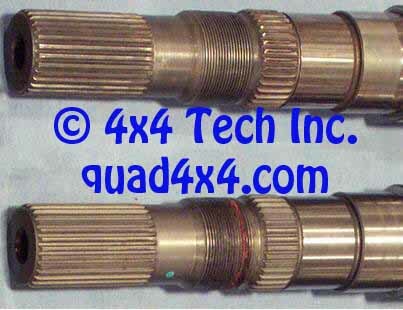
Stock New Venture mainshafts from Dodge NV4500HD transmissions
The top shaft had the typical fifth gear failure. The splines are worn and you can see the wear marks in the support surface to the right of the splines.
The lower shaft is a new takeout in perfect condition. Note, the support surface is smooth
The aftermarket introduced two types of imported mainshafts with nearly full-length splines in an attempt to remedy the problems experienced with the factory shafts. The splines on these shafts are considered flexible in the sense the gear is not supported by pilot rings at either end so it can flex, or rock under load. Both styles are used with the same fifth gear design as the original equipment. These shafts are most often sold with an aftermarket mainshaft nut that has two set screws.
First on the market was a shaft with splines that were made to provide a fairly light interference or press fit with the gear splines. This shaft design was introduced by Blumenthal Manufacturing of Oklahoma City. Next on the market was a shaft made for gear wholesaler Midwest Transmission of Zumbrota, MN. With this design, the shaft splines are near full length but machined to be a slip fit with the gear. This shaft is grooved to allow a 3 piece thrust washer to be inserted between the gear and retaining nut. Both of these shaft designs received tremendous positive press coverage as permanent cures for 5th gear failures and were enthusiastically sold by almost everyone in the transmission repair business including us. Unfortunately, great confidence in these designs has not proven to be fully justified. While the percentage of 5th gear and related failures is probably lower with either full spline shaft design in comparison to the factory shafts, the cold truth is full spline shaft failures are occurring.
With the press fit type full spline shaft, gear failures are identical to the original equipment shaft. In other words, the gear loosens up on the shaft and eventfully works the nut off the threads. To have any chance of keeping the fifth gear in place, the press fit between the shaft splines and gear splines with this type of shaft must be quite tight. We rejected nearly 50% of the shafts we bought of this design because they did not provide a tight enough fit with the gear. Long before we ever even heard of any failures with this type of shaft, I discussed the importance of accurate machining with the importer and the need to increase the spline contact to prevent the same types of problems we had with the factory shafts.
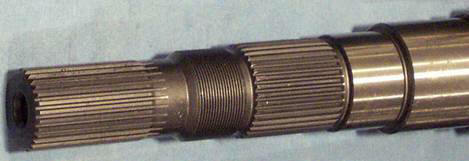
Full Spline Shaft with Light Press Fit Splines
The other full spline shaft utilizes a thrust washer between the gear and nut. With this design, I know of no instances where the nut backed off. On the downside, this shaft was designed so the 5th gear will easily slip onto the shaft. This slip fit means the gear and shaft splines may eventfully wear themselves away, at which point you could lose fifth even though the nut is still in place. This is a very noisy failure as the spline nubs jump over each other, plus all the worn-away spline material contaminates your oil. There is one other major issue with this shaft. A secondary function of the fifth gear is to keep the mainshaft rear bearing tight against a thrust washer. With this shaft design, the loose-fitting gear cannot hold the bearing tight. If this bearing is not held tight, it tends to wear into the shaft and thrust washer which increases end-play. Excessive end-play can lead to shifting problems, shaft misalignment, and catastrophic failure. This style of the shaft is somewhat weaker than other designs due to the reduced shaft diameter at the thrust washer groove. Breakage is not common, but it does occasionally snap in high-load situations. Despite the potential shortcomings, this shaft design is very popular with both professional rebuilders and shade tree mechanics because assembly is fast and easy without any press tools.
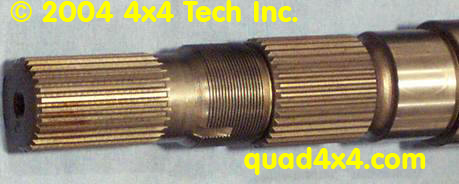
Full Spline Shaft grooved for thrust washer.
The Surprise Culprit Is...
The 5th gear splines used on all NV4500 transmissions are of side fit, involute configuration. Involute splines are self-centering, have curved sides, and offer greater torque-transmitting capacity than any other type. Side fit means only a portion of the flanks of each spline are in contact with the mating spline and it is this characteristic that is culprit #1 in the Case of the Lost 5th Gear.
Side fit and involute splines are widely used and well proven for transmitting inline torque. Common examples include input shafts, output shafts, synchronizer hubs, transfer case chain sprockets, propeller shaft slip yokes, pinion yokes, and axle shafts. This spline style is not often used to transmit torque in applications where the torque input is from the side as is the case of the NV4500 mainshaft fifth gear unless there is some type of additional support (such as pilot rings) to prevent the gear from rocking on the shaft. None of the previously discussed mainshafts use any type of ring or pilot to prevent axial movements from occurring under load although the factory gear does derive some weak support from the unspliced portion of the shaft.

If you take a magnifying glass and view a cross-section of a 5th gear pressed on the mainshaft splines, you will clearly see the no-contact areas between the tips of each spline and the root of the matching spline. You can also see how short the contact surface is between mating splines. The 5th gear to mainshaft contact area of the mating splines is less than .040 high. The unsupported, no-contact areas or voids, are greater than 1/2 the distance from the minor diameter of the shaft to the major diameter of the gear. With both the factory and full spline shafts these unsupported areas are where wear and eventual failure begin. Such movement will be minute at first, but over time it will increase as the matching parts wear. To eliminate movement, we must have effective and rigid support for the 5th gear. To do this we need to change the design of the shaft, gear, and retaining nut.
Now, let's turn our attention back to the much-maligned factory mainshaft with its partial 5th gear spline. These shafts have a spline length of just under. In addition, for additional gear support, there is a smooth machined surface just over 1 long. For manufacturing reasons, there are also reduced diameter areas between the splines and support surface and between these two features and adjacent portions of the shaft. The matching gear (which is also used on both full spline shafts) is 2.25 long with internal splines cut the length of the gear. The gear splines are beveled at each end.
Many people assume New Venture chose partial splines over full splines because it was cheaper. The fact is it is more expensive to make a partial spline shaft. Why? The splines are rolled before the shaft is hardened. After the shaft is heat treated to harden it, the support surface is ground to a very, very precise dimension. New Venture could have saved money by rolling full-length splines in the first place. So why didn’t they? Well, I can t be sure, but a comment made to me by a New Venture engineer about the importance of keeping 5th gear concentric on the shaft had to be a consideration. New Venture tried to use the gear splines pressed onto a smooth support surface instead of pilot rings. This approach is reasonably effective with gas engines and moderate loads. However, with diesel, the engine harmonics and horsepower in heavy-duty applications create loads beyond what this design can handle without wear given the shaft size. With a factory mainshaft and gear, you typically lose 5th gear when the gear splines have worn into the shaft to the point where repeated axial gear movement works the nut free. New Venture tried to fix the problem by addressing the consequence (by changing the nut design) of the gear working loose, instead of the cause (insufficient gear support). End result: A big problem and a bad reputation for an otherwise excellent transmission.
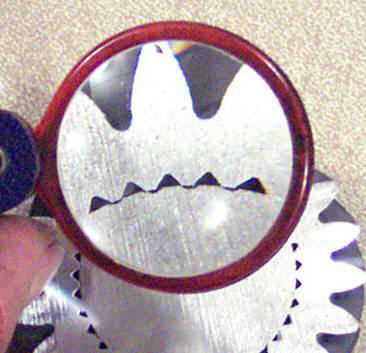
Cross-section view of 5th gear pressed over an unspliced portion of factory shaft.
Look through the magnifying glass and note how splines have already slightly indented shafts when pressed on.
Now, let's take a look at the press fit and full spline shaft. The theory here is that longer splines are better, but the side contact, flexible spline with its limited spline-to-spline contact, and large unsupported areas make this design subject to the same types of failure as experienced with the factory mainshaft. Some support can be derived by having a very tight fit between the gear and shaft. However, with the average fit, premature failure is a distinct possibility.
The concept of the thrust washer-style full spline shaft is simple. The design assumes the gear is going to come loose anyway, so they grooved the shaft to accept a split thrust washer between the gear and nut. With this design, the thrust washer will probably keep the nut on. The problem here is the designers concentrated on preventing the nut from backing off and ease of assembly. In this they were successful, however, by making the shaft so fifth gear and the rear bearing would be a slip fit, wear and fretting are almost guaranteed. Result: potential for reduced service life.
Spline Cross Sections Showing Progressive Wear.
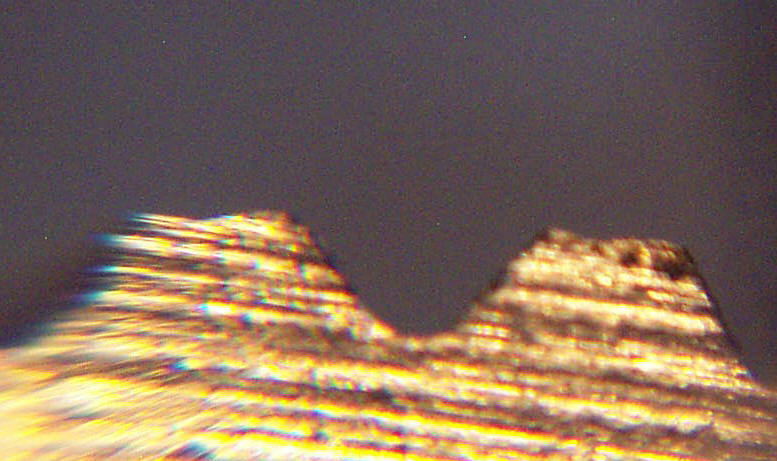
(above) New, unworn involute splines. Note the sides of the teeth are slightly curved. Also, note the tips are slightly concave from being rolled.
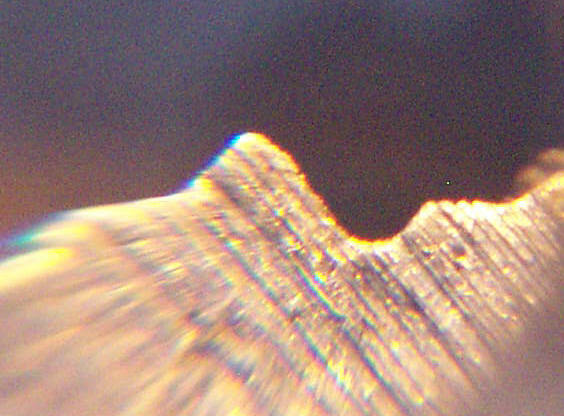
(above) Typical wear found on a factory shaft or press fit full spline shaft after the second failure when the gear was just reinstalled to temporarily return the transmission to service. Note the spline is worn almost to a knife edge.

(above) Worn-off splines are typical of thrust washer-type full spline shafts when the gear jumps the splines. The matching gear splines are similarly worn.

Close-up of groove and thrust washer style, full spline mainshaft. One split washer is removed to show detail.
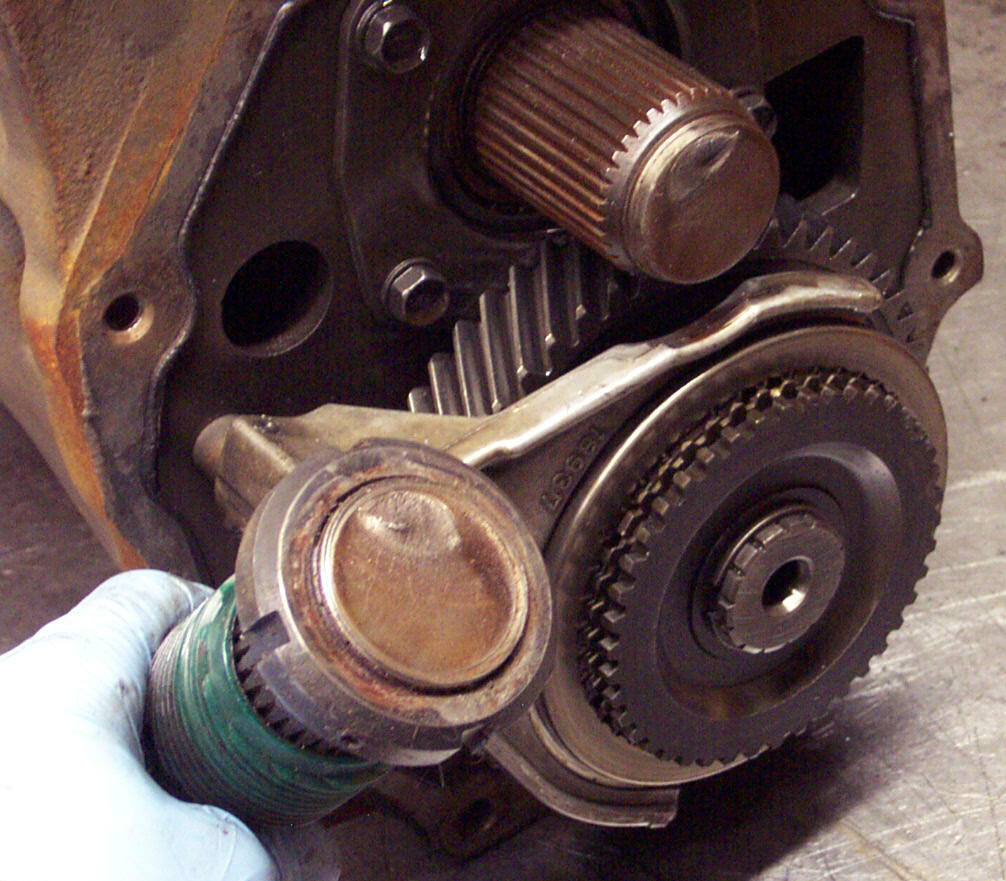
Thrust Washer Style Mainshaft broke off at Thrust Washer Groove
Comparison to Ford ZF42 and ZF47
So far, we have only talked about the NV4500 in GM and Dodge vehicles. How did they stack up against the contemporary Ford ZF42 and ZF47 5 speeds? These transmissions have many durability issues but losing fifth gear isn’t one of the common ones. Unlike the 4500 with its fixed mainshaft gear and bearing supported countershaft gear, the ZF s used an extremely tight, press fit between the gear and countershaft with no splines or keys. On the mainshaft, the gear is supported by a two-piece bearing. The rear output bearing is outboard of the gear. The bearing is held in place by a snap ring on 4x4 models or the rear output yoke on 4x2 trucks. Since the bearing is outboard of the gear, lateral gear movement is limited. To be sure, most of the Ford Diesels coupled to these transmissions were rather anemic compared to the Cummins, but the fact is the basic 5th gear design was more trouble-free than the NV4500.
What Next?
So, you ask Is there any solution to this problem besides a different truck and/or transmission? Well, yes there is. The answer is pretty simple (increase gear support), but it required redesigning the mainshaft, gear, and retention system.
The Challenge
The root cause of NV4500 mainshaft fifth gear failures is simply insufficient to support the fifth gear under real-world conditions. The solution is also simple: increase support. Providing a practical and customer installable design at a reasonable cost was the challenge. We also wanted to offer the improved design for all NV4500 transmissions including GM and Dodge light-duty models.
New Design Features
First off, we knew we had to use a partial, fixed spline shaft to eliminate the rocking motion of the gear that plagues all previous mainshaft designs. The unspliced area is increased in diameter to a size larger than the shaft splines. This gear design was modified from a full spline to a partial spline. The area without splines is precision machined to provide an interference or press fit with the larger diameter, unspliced area on the mainshaft. Depending upon the application, the gear may be shorter or longer than stock. The rear gear face for most applications is modified to accept a pilot ring. The rear single lock nut is replaced by either a double or triple nut retaining system. The outer nut is a lock nut. The inner nut may be flat or incorporate a pilot ring depending upon the application. On new shafts, a hardened, tanged thrust washer is also used. For retrofit kits, a Belleville spring lock washer is used. We also had to invent several new tools to ease installation. To increase holding power and decrease the chance of vibration-induced fretting, we use several Permatex locking compounds with 3, 000-4, 000 psi. shear strengths. Our Patented design is known as the Torque King.
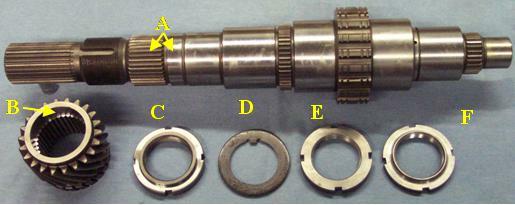 The Patented Torque King eliminates NV4500 5th gear failures!
The Patented Torque King eliminates NV4500 5th gear failures!
A. Longer Splines (left arrow) Shaft Pilot (right arrow)
B. Counterbore under gear teeth (fits A)
C. Inner nut with machined pilot ring
D. Hardened Anti-Rotation Washer
E. Center Nut
F. Outer nut with a lip to stake in key slot
Benefits of the Torque King
What's all this mean to you? Dependability and reliable performance unmatched by any other NV4500 mainshaft/gear design. With the Torque King design, the splines have one function and one function only; to transmit torque from the gear to the mainshaft. The gear is supported and kept concentric on the mainshaft, by press fits between the smooth gear bores and supporting rings. With this design, the troublesome axial movements and wear that caused factory and full spline shaft failures are eliminated. Under identical service conditions, a transmission with the Torque King will provide longer and more trouble-free service than any factory or full spline mainshaft. Less downtime and longer life make the Torque King the most cost-effective way to keep your NV4500-equipped truck in service. Whether you rely on your truck for commuting, work, or touring, you can put your mind at ease about 5th gear failures with the Torque King, the mainshaft and fifth gear system designed and built to last.

With Torque King matched shaft and gear sets, the splines have only one function: transmit torque. The gear is rigidly supported by pilots. A close-up of the inner nut shows how the pilot ring is machined as part of the hardened inner nut. This ring fits a very accurately machined, matching counterbore in the rear of the gear. Torque King gears for most Dodge applications use fixed splines with a long pilot ring under the gear teeth and a short pilot on the nut as shown here. GM applications are piloted under the gear teeth only due to design differences on GM NV4500 transmissions.
Dan The Gear Man Tech Note: When I retired from the day-to-day operations of the business and turned over the reins to the younger family members, it was with the understanding I would not override their decisions. When the time came to renew the long-term production contract for our Torque King Mainshaft Sets, the family looked at the advancing age of NV4500 equipped vehicles, plus the unavailability of original equipment or better 3rd, 4th, and countershaft gearing. After deliberation, the decision was made to let the contract lapse even though Torque King's sales reached a record high in 2011. My arguments that Cummins-powered trucks with NV4500 transmissions are going to stay on the road for many years did not carry the day. So as of January 2012, we sold out on Torque King mainshaft Sets and Master Overhaul Kits for New Venture NV4500 transmissions. There are no plans at this time to resume production.
Torque King In Vehicle Retrofit Kits
Have an otherwise serviceable NV4500 that just suffered its first fifth gear failure? Return your transmission to service without removing it from the vehicle with the Torque King Retrofit Kit. This unique kit consists of a precision machined steel sleeve that is installed over the worn support surface of your factory mainshaft, a Torque King press fit gear, a double nut package with a lockwasher, a rear output seal, special tools, several Permatex products, and required tools. The Torque King Retrofit Kit is the only fix on the market that restores the critical press fit between the gear and shaft. Plus, this innovative new kit provides steel support rings for both sides of the gear. The splines are only used to transmit torque. Permatex Bearing Mount is used to restore the fit of the worn mainshaft splines. This Kit is only recommended for use on a transmission that 5th gear has either not failed or just failed for the FIRST time!
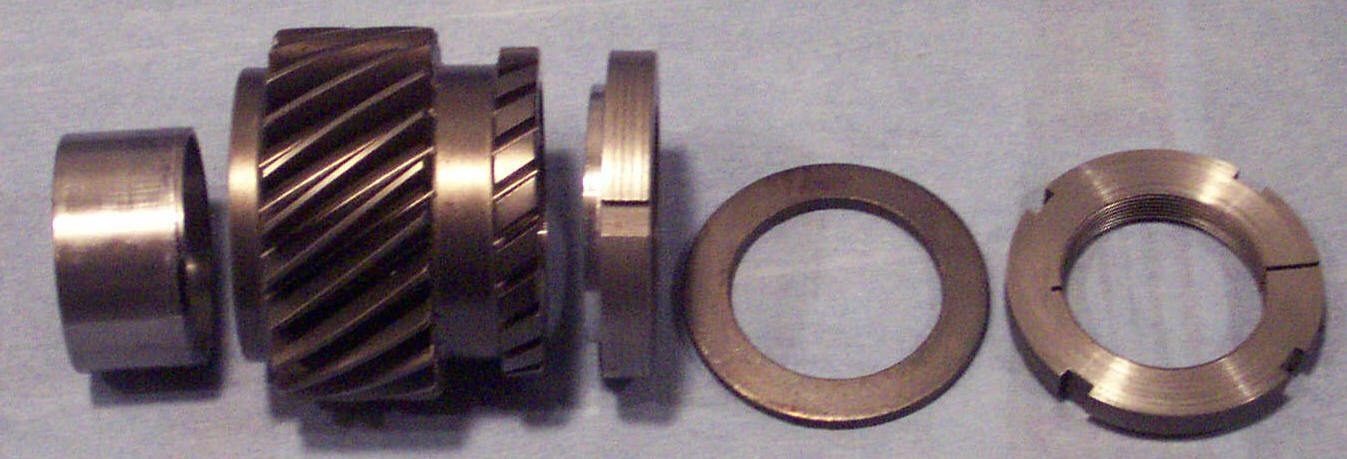
Torque King Retrofit Kit for NV4500 Transmissions (Early NV4500HD Kit shown here)
When NOT to Use the Torque King Retrofit Kit
If your NV4500 with a factory mainshaft was returned to service after the first 5th gear failure with any combination of factory gear, nut, bearing lock, welding, etc., it will have severely worn splines and excessive bearing end-play. These types of temporary repairs MURDER your transmission and we absolutely do not recommend using our Retrofit Kit under these circumstances as your transmission is in desperate need of a total rebuild. In fact, we won't even sell you a Retrofit Kit if we know this!
If you have a high mileage transmission with 150,000 miles or more, we recommend you have it rebuilt instead of installing the Retrofit Kit. High mileage transmissions usually have excessive end-play which is a good indication the useful service life of the bearings is about over.
The Torque King Retrofit Kit is only compatible with genuine New Venture original equipment mainshafts. It will not work with any aftermarket shaft of either full or partial spline design!
REFERENCES
An excellent reference for mechanical design and manufacturing is the Machinery s Handbook published by Industrial Press, 200 Madison Ave., New York, NY 10016. Phone: 1-888-528-7852. We derived much of the information we used in identifying the reasons for fifth gear failures and in the invention of the Torque King from this source.
Instruction Sheet K6855309 from the Chrysler Motors Mopar Parts Division dated 7/1/98 and revised 9/23/98 details the service procedure for the clamp mainshaft nut in repairing fifth gear.
The following statement appears:
Caution: if the fifth gear nut has backed off in operation, then fifth gear replacement is also required with the fifth gear nut. . No mention was made about mainshaft wear or the chances this fix would hold up when installed on a worn-out shaft.
Two interesting back-to-back articles appeared in the Turbo Diesel Register on this subject in issues 30 (pg.36) and 31 (pg. 23). These articles were major factors in acceptance of the thrust washer design, full spline shaft as the end-all cure for 5th gear failures. The full spline shaft sold by Standard Transmission Transmission and Gear Company of Texas was a major topic of both articles. We purchased one of these shafts from Standard Transmission in 2002 which is identical to the shaft imported by Midwest Transmission. The shortcomings of the thrust washer design full spline shaft that we detailed in our discussion above were not readily apparent when these articles were written. For reprints, Contact TDR at 770-886-8877. Address: 1150 Samples Industrial Drive, Cumming, GA 30041. On the web: turbodieselregister.com.
An article I wrote on Catastrophic Manual Transmission Failures appeared in issue 44 of the Turbo Diesel Register starting on page 142. To view a generic version of this article, click here: Causes of Manual Transmission Failures
